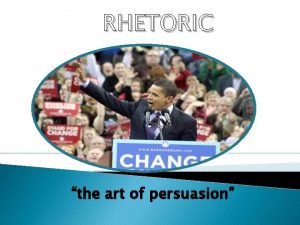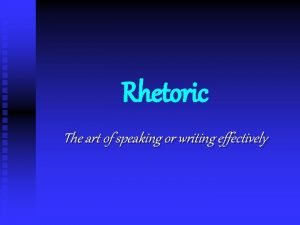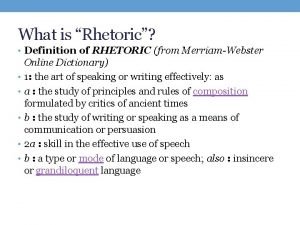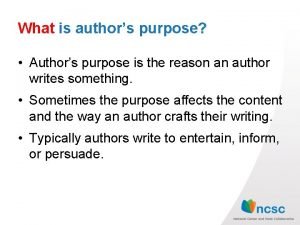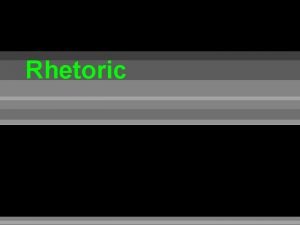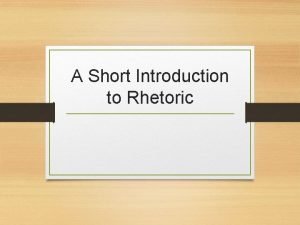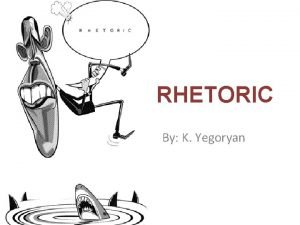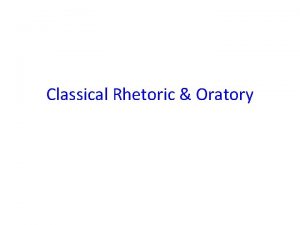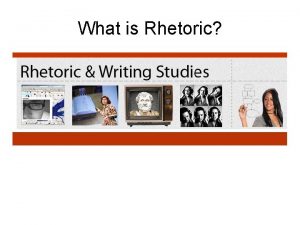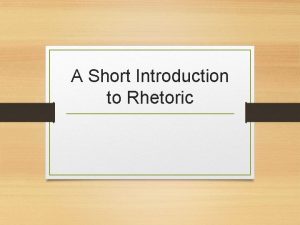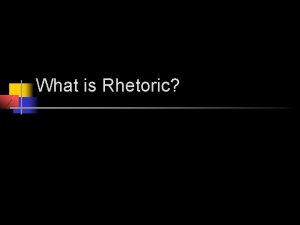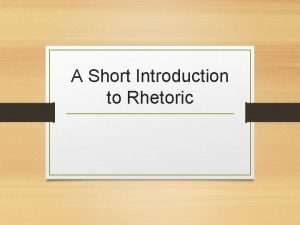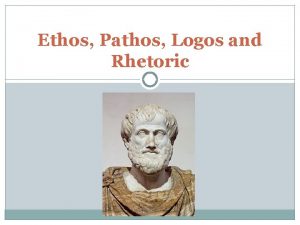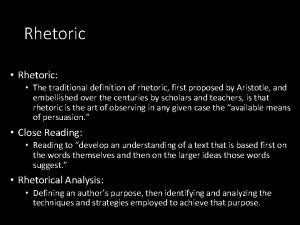Rhetoric Lesson 2 Writing Tip of the Day














- Slides: 14

Rhetoric Lesson #2

Writing Tip of the Day #1 – Active vs. Passive Voice Active voice: Subject of the sentence conducts the action (simple subject-verb construction) Ex: The quick brown fox jumps over the lazy dog. The quick brown fox [subject] jumped [action] over the lazy dog [object].

Writing Tip of the Day #1 – Active vs. Passive Voice Active voice: Subject of the sentence conducts the action (simple subject-verb construction) Ex: The quick brown fox jumps over the lazy dog. The quick brown fox [subject] jumped [action] over the lazy dog [object].

Passive voice: The subject of the sentence is acted upon. Ex: The lazy dog was jumped over by the quick brown fox. The lazy dog [object] is jumped [action] over by the quick brown fox [subject].

Is this sentence active or passive? The new book, Harry Potter and the Deathly Hallows, was read by my brother in one day.

Revised for active voice: “My brother read the new book, Harry Potter and the Deathly Hallows, in one day. ” More often than not, use active voice so that the subject of your sentence does the action. It makes your sentences clearer and simpler to say.

Passive voice: The subject of the sentence is acted upon. Ex: The lazy dog was jumped over by the quick brown fox. The lazy dog [object] is jumped [action] over by the quick brown fox [subject]. More often than not, use active voice so that the subject of your sentence does the action. It makes your sentences more clearer and simpler to say.

What is rhetoric? How would you define it? What does it entail? Does it have any positive or negative connotations?

Usually, rhetoric is defined as the art of communication. Consists of the functional aspect of writing Also understood as a mode of argument Most importantly, rhetoric is about ACTION For all these reasons, rhetoric is everywhere

Successful writers must understand their rhetorical situation. Rhetoric involves four elements: writer, reader, text, and medium. Also involves Kairos, or “timeliness” Analyze your rhetorical situation consciously before putting words on paper

One of the great, eternal commandments of writing: KNOW THY

Aristotle’s Three Appeals Logos: appeal to reason Pathos: appeal to emotion, values, and beliefs Ethos: appeal to the credibility of the author Consider these three appeals before addressing an audience

Rhetorical Appeals Group Activity Which appeals would you use in each situation to persuade your audience? Situation #1 – Your teacher is about to fail you unjustly Situation #2 – You want to get back together with your boyfriend or girlfriend Situation #3 – Your boss at work asks you why you should get a raise

Opinion Editorials
 Day 1 day 2 day 3 day 4
Day 1 day 2 day 3 day 4 Takatuka bilmecesi
Takatuka bilmecesi Day 1 day 2 day 817
Day 1 day 2 day 817 Rhetoric: the art of persuasive writing and public speaking
Rhetoric: the art of persuasive writing and public speaking Rhetoric: the art of persuasive writing and public speaking
Rhetoric: the art of persuasive writing and public speaking Inclusive onboarding
Inclusive onboarding Environmental tip
Environmental tip Visual rhetoric
Visual rhetoric Rhetoric merriam webster
Rhetoric merriam webster Definition of authors purpose
Definition of authors purpose What is rhetoric
What is rhetoric 3 types of rhetoric
3 types of rhetoric Canons of rhetoric
Canons of rhetoric Logos ethos pathos
Logos ethos pathos Five classical canons of rhetoric
Five classical canons of rhetoric



